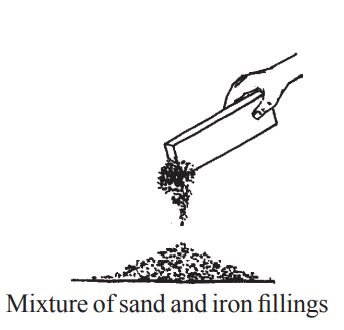Published by: BhumiRaj Timalsina
Published date: 01 Feb 2022
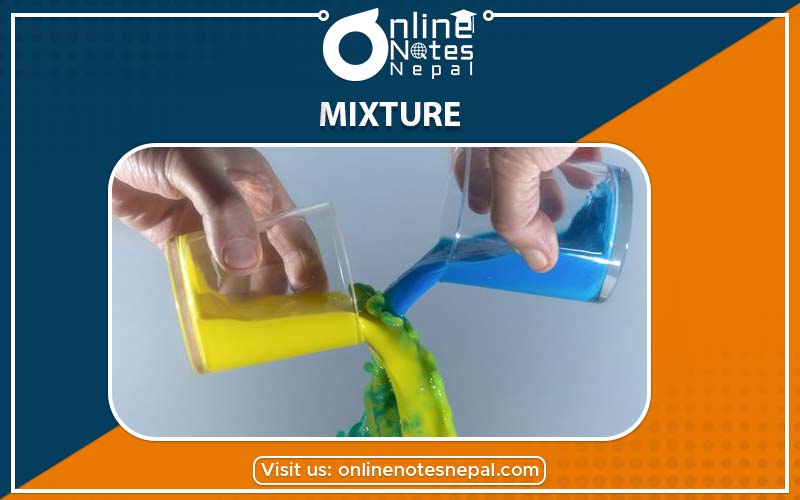
We use various kinds of substances in our daily life. For example- rice, tea, milk, etc. Tea, we drink, consist of milk, tea leaves, sugar, water, etc. Rice we eat may be mixed with stone, husk and unwanted seeds. Similarly, air consist of oxygen, carbon dioxide, nitrogen and other gases. In this way, the combination of two or more substances is known as mixture. The constituents of mixture are known as its components. Air is a mixture. It is made up of nitrogen, oxygen, carbondioxide, and other gases. Therefore, nitrogen, oxygen, carbondioxide and other gases are components of air. The properties of components of mixture are not lost and they are not mixed in any fixed proportion. Components of mixture can be easily separated with various physical methods.
We use different kinds of mixture in our daily life. For example- during summer we drink fruit juice, cold drinks, etc. These substances are made up of different components. In same way, in tea we mix tea leaves, water, milk and sugar. During rainy season river water becomes muddy and we can easily distinguish water, sand, soil, etc. Also, while eating rice sometimes we find stones, piece of bricks, etc. These are the examples of mixture. On the basis of components of mixture they can be divided into two types. They are:
a) Homogeneous mixture
b) Heterogeneous mixture
Activity 1.
Take two glasses of the same size and put half glass water in each of them as shown in figure. In one glass put a teaspoon full of salt or sugar. While in another glass put a teaspoon full of sand or soil. Stir the content in each of the glass. Now ask your friend to observe the particles in the glasses. After keeping the glasses still for about 2 minutes now ask again to the friend for the observation. What change is seen ? Salt or sugar dissolves in water . While sand and soil do not dissolve in water and hence precipitate on the bottom of glass.
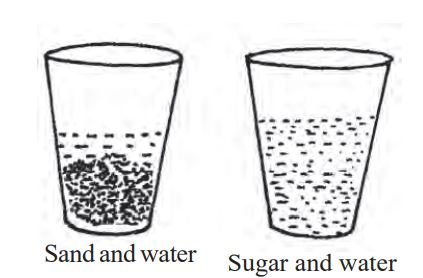
In this way, if the constituents of mixture are mixed homogeneously, it is called the homogeneous mixture.For example mixture of salt and water is a homogenous mixture. On the contrary, if the constituents of a mixture are not mixed homogeneously, then it is called heterogeneous mixture. For example mixture of sand and water is a heterogeneous mixture.
We know, when two or more than two substances are mixed together and they do not undergo chemical change. They form mixture. The process of separating various components of a mixture is known as separation of mixtures. This process is done when any component of a mixture is unwanted or in order to obtain useful component from the mixture . The components of mixture can be separated after studying their properties. There are different methods of separation. Among them we are going to study about sedimentation, filtration, winnowing, sieving and magnetic separation.
This method is applied to separate a mixture of solid and liquid, or other heavier liquid matter. For example- separation of water and soil or sand from muddy water.
Activity 2
Take one glass or beaker. Pour water in it. Put soil or sand inside it and stir it with a glass rod. soil or sand does not dissolve in water. Keep the mixture still and see what happens. The insoluble solid particles go down and settled at the bottom of the container. This is called sedimentation. Now tilt the beaker gently and pour the clear water into another beaker. This is known as decantation. In this way, water and soil or sand particles are separated.
With help of filtration, mixture of insoluble solid particles can be separated from the liquid. While making tea we use clean clothes or wire net to separate tea leaves from tea. This process is known as filtration. We can also separate water and sand by this method.
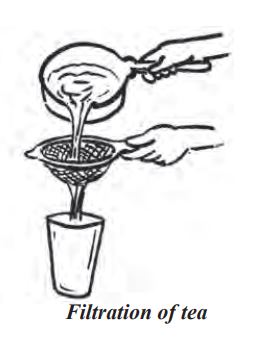
Activity 3
Take a beaker. Pour water in it and put some sand or soil inside it. Take a thin piece of cloth or wire net. Put that thin piece of cloth or wire net on another beaker. Now pour the mixture of water and sand on it slowly. In this way, clear water is collected in beaker and sand or soil particles remain on the cloth.
Similarly, in laboratory we can use filter paper to separate the components of heterogeneous mixture. The filter paper is in a circular form of small sizes. Filter paper is folded into the shape of cone. With the help of filter paper water and soil can be separated from muddy water. In this Winnowing With the help of winnowing, the mixture of heavier and lighter solid particles can be separated. We have seen the separating of rice from husked rice in our village. In this method, a farmer drops the way, the process of separating solid particles from liquid by passing the mixture through fine holes is known as filtration. The solid particle which cannot be passed through from the holes and thus remains on filter paper is known as residue. The clear liquid which can pass through the holes is known as filtrate. Here, water is filtrate and soil is residue.
With the help of winnowing, the mixture of heavier and lighter solid particles can be separated. We have seen the separating of rice from husked rice in our village. In this method, a farmer drops the rice from the height with the help of winnowing tray. Rice grains are heavier than husk so, air flow the husk farther than the rice grains In this way they are separated from each other. Thus, the method of separating the lighter solid particles and heavier solid particles with the help of air is called winnowing.
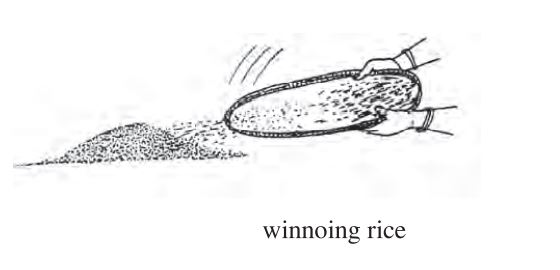
Different size of solid mixture can be separated from sieving method. You may have seen people separating the unwnted solid particles from the flour using sieve. This method is called sieving.
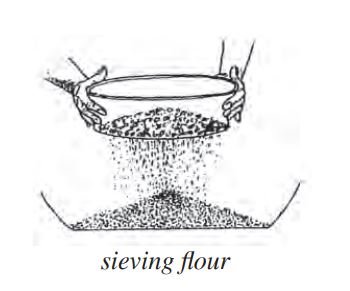
Activity 4
sieving flour Take a sieve. Put some flour on it. Now, slowly move the sieve from side to side. You will observe that the flour will fall down on the plate beneath the sieve while the wheat bran remain on the sieve. The way of separating the solid substances from the flour by using a sieve is known as sieving method. During the construction of the house the separating of sand and stones is done by using this method.
By using a magnet, we can separate different magnetic substances from any mixture. We use magnet in this process. In this method, we put the mixture on top of the paper or a card board and move the magnet around it. The magnetic substances get attracted to the magnet and magnetic substances can be separated from non-magnetic substance. By this method, we can separate magnetic substances from a mixture.
Activity 5
Take iron fillings and sand. Mix them together. Now, put the mixture on top of a paper. Take one magnet and move it around the mixture. What do you think will happen? Discuss it and write. The iron fillings in the sand will get attracted to the magnet. By this way, we can separate magnetic substances from the mixture through the help of a magnet. This method is known as magnetic separation.
